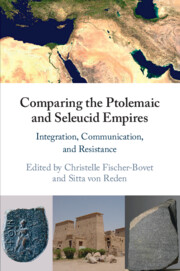Book contents
- Comparing the Ptolemaic and Seleucid Empires
- Comparing the Ptolemaic and Seleucid Empires
- Copyright page
- Contents
- Contributors
- Preface
- Note on Abbreviations
- Maps
- Introduction
- Part I Cities, Settlement and Integration
- Part II Communication and Exchange
- Chapter 5 Imperial and Indigenous Temporalities in the Ptolemaic and Seleucid Dynasties
- Chapter 6 The Visual Representation of Ptolemaic and Seleucid Kings
- Chapter 7 Monetary Policies, Coin Production, and Currency Supply in the Seleucid and Ptolemaic Empires
- Part III Collaboration, Crisis, and Resistance
- Bibliography
- Index
Chapter 6 - The Visual Representation of Ptolemaic and Seleucid Kings
A Comparative Approach to Portrait Concepts
from Part II - Communication and Exchange
Published online by Cambridge University Press: 17 September 2021
- Comparing the Ptolemaic and Seleucid Empires
- Comparing the Ptolemaic and Seleucid Empires
- Copyright page
- Contents
- Contributors
- Preface
- Note on Abbreviations
- Maps
- Introduction
- Part I Cities, Settlement and Integration
- Part II Communication and Exchange
- Chapter 5 Imperial and Indigenous Temporalities in the Ptolemaic and Seleucid Dynasties
- Chapter 6 The Visual Representation of Ptolemaic and Seleucid Kings
- Chapter 7 Monetary Policies, Coin Production, and Currency Supply in the Seleucid and Ptolemaic Empires
- Part III Collaboration, Crisis, and Resistance
- Bibliography
- Index
Summary
This chapter looks at what the author calls a “system of visual communication” in the Seleucid and Ptolemaic empires. It focuses on “portrait concepts,” which refers to the double process of inventing an ideological image of the king’s public body, on the one hand, and maintaining the conventions of particular visual media, the interests of the composer, and the expectations of the recipients, on the other. The portrait concept thus encapsulates communication and exchange before it reaches the viewer’s eyes. Von den Hoff identifies three different periods in terms of their visual systems of communication. Between 323 and 280 BCE, during the Wars of Succession, there was close entanglement between Ptolemaic and Seleucid portrait concepts. They drifted apart in the subsequent period (280–160) due to dynamically changing local challenges. In the final period (160/40 to c. 100), there was a renaissance of earlier types of portraiture. The author’s emphasis on imperial entanglement in the first period, diversification in the second, and historicizing endeavors in the final period raises questions about the local background to which the visual representation of the kings responded.
- Type
- Chapter
- Information
- Comparing the Ptolemaic and Seleucid EmpiresIntegration, Communication, and Resistance, pp. 164 - 190Publisher: Cambridge University PressPrint publication year: 2021
- 1
- Cited by



